Helps you fine-tune every sound, master natural rhythm, and build the confidence to speak English like a pro—anytime, anywhere. 🌍🎵
✨ Master the art of 🗣️ clear speech and 🎵 natural intonation. 📈 Improve your pronunciation, 🎯 refine your accent, and 💬 express yourself with confidence in every conversation 🌍.
Helps you fine-tune every sound, master natural rhythm, and build the confidence to speak English like a pro—anytime, anywhere. 🌍🎵
Did you know? In English, not every part of a word is spoken with the same strength. Some syllables are stronger and louder, while others are softer. This difference is called Word Stress.
Getting word stress right makes your English sound clear, natural, and easy to understand. If you miss it, people might still understand you—but your speech could sound flat or confusing.
👉 In this lesson, you’ll listen, repeat, and practice stress in common words. Try to copy the rhythm just like in music—because English really does have its own beat!” 🎶
🖱️ Click on the words in the chart below to hear the correct stress and syllable emphasis.
🎧 Listen carefully, then repeat aloud to practice your natural English rhythm!
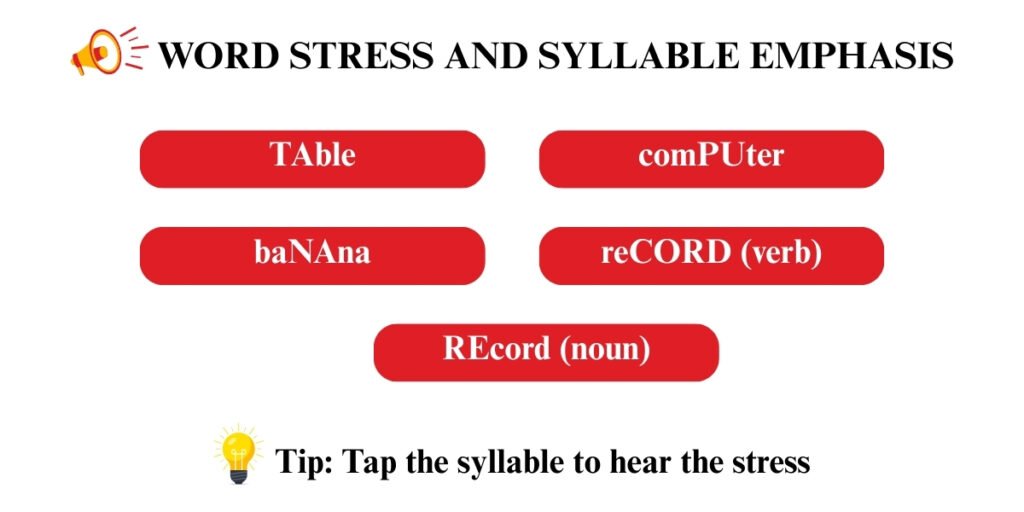
Clear pronunciation starts with clean vowels and crisp consonants. If your vowel sounds are not sharp, words can sound unclear or even change meaning. For example, bit and beat are only different because of vowel length. Similarly, if consonants like “p” and “b”, or “t” and d” are not pronounced clearly, your speech may sound confusing.
In this lesson, you’ll:
✔️ Learn the difference between short and long vowels
✔️ Practice common minimal pairs (words that differ by only one sound)
✔️ Strengthen your consonant sounds for crisp, natural English
💡 Why it matters: Vowel and consonant clarity makes your English sound easy to understand and more confident. It’s like tuning a musical instrument—small adjustments can make a big difference in how you’re heard.
👉 Listen, repeat, and practice with the examples below. Focus on the length of vowels and the sharpness of consonants to improve your clarity step by step.
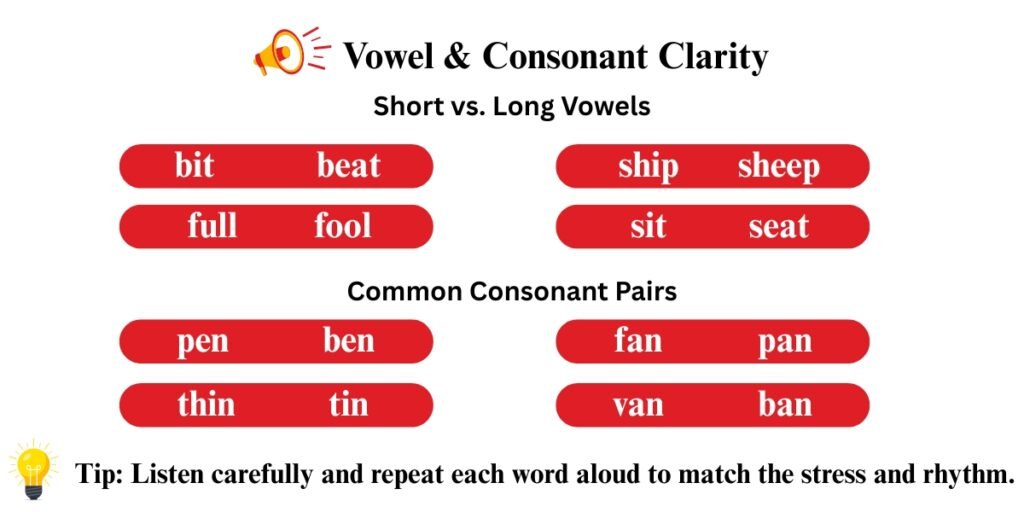
🔊 Did you know? In English, the way a word is spelled and the way it is spoken are often different. Unlike some languages where letters always sound the same, English spelling can be tricky!
For example:
“ough” can sound different in though, through, and rough.
The same letter can change sound in different words, like a in cat vs. cake.
That’s why it’s important to practice listening to sounds and not only depending on spelling. This will help you speak more naturally and understand English faster.
👉 In this lesson, you’ll listen, repeat, and practice common examples where spelling and sound don’t match.
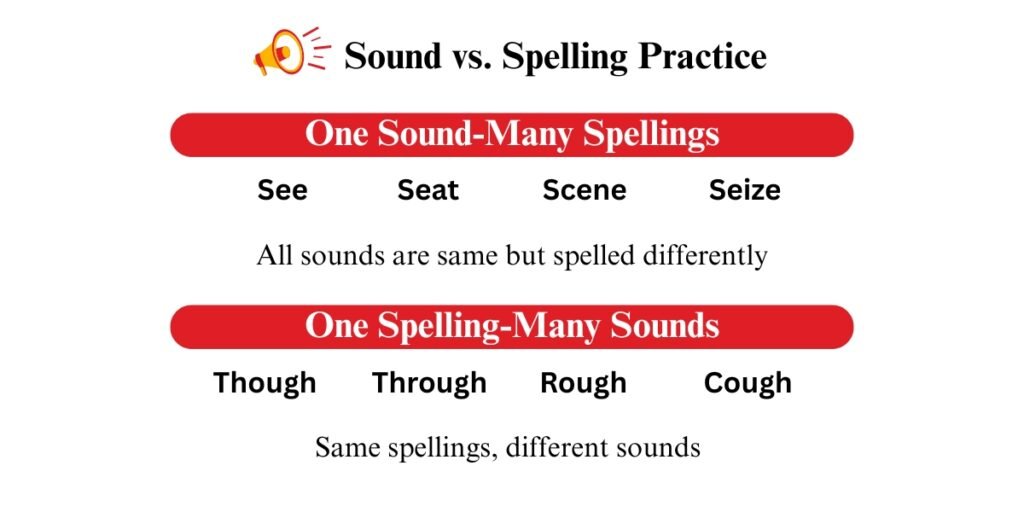
Pronunciation is one of the most common challenges for learners of English in India. Even if your vocabulary is strong and your grammar is perfect, mispronouncing words can sometimes make it difficult for others to understand you clearly. Small mistakes in vowel sounds, consonants, word endings, or stress patterns can change the meaning of a sentence or make your speech sound less natural.
In this lesson, we will focus on the most frequent pronunciation errors made by Indian learners, and you will learn simple, practical techniques to correct them. We will cover:
Vowel sounds that are often confused, like short vs. long vowels
Consonant sounds, including tricky sounds like /th/ and the difference between /v/ and /w/
Silent letters that are commonly pronounced by mistake
Word endings, which affect meaning and clarity
Stress and intonation patterns, which make your speech sound more natural and confident
Each section of this lesson comes with step-by-step instructions, example sentences, and repetition exercises to help you practice effectively. By following these exercises regularly, you will gradually improve your clarity, sound more confident, and make your English easier to understand for anyone you speak with.
So get ready to listen carefully, repeat after the examples, and practice consistently. This lesson will give you the tools to speak English more clearly, naturally, and confidently than ever before!
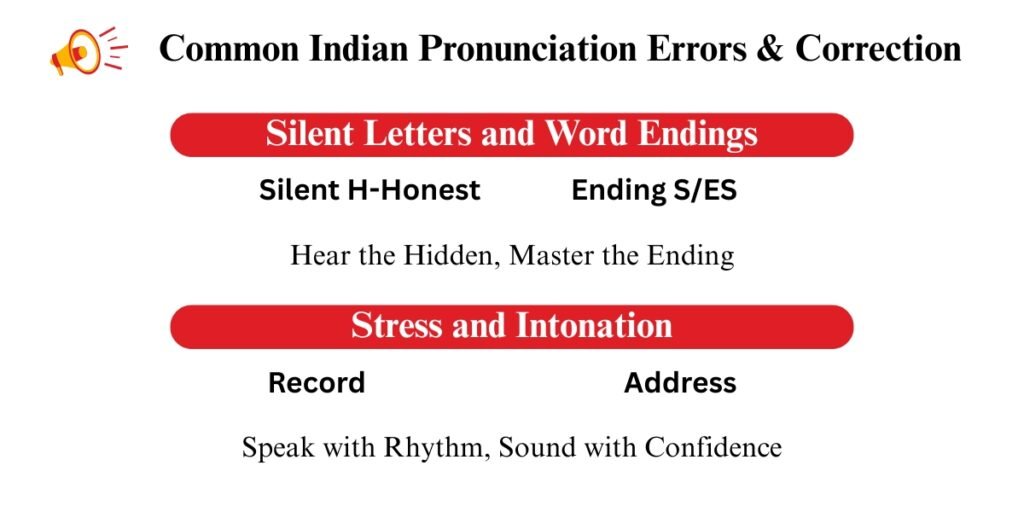
Introduction
Speaking English confidently starts with understanding how words and phrases sound in real conversations. At the beginner level, listening carefully to common phrases and repeating them correctly is one of the fastest ways to improve pronunciation, rhythm, and accent. This module focuses on practical phrases used in everyday situations, helping learners build a natural speaking flow.
Why This Is Important
English has unique sounds and stress patterns that are not always intuitive for beginners.
Repeating phrases after listening helps train muscle memory in your mouth and tongue.
It improves listening comprehension and fluency, making speaking more natural.
Regular practice reduces the fear of speaking and helps learners sound more confident.
Start with short phrases like greetings, introductions, and polite expressions.
Focus on pronunciation, stress, and intonation rather than meaning initially.
Listen multiple times to get familiar with the rhythm of each phrase.
Examples of Common Beginner Phrases:
Hello! How are you?
Good morning!
What’s your name?
I’m fine, thank you.
Please help me.
Excuse me, can you repeat that?
Tip: Use audio from the website so you hear native-like pronunciation.
Repeat the phrase immediately after listening.
Mimic the rhythm and stress exactly as you hear it.
Record yourself to compare your pronunciation with the audio.
Repeat each phrase 5–10 times until it feels natural.
Example Practice Routine:
Listen: “Good morning!”
Repeat: “Good morning!” (matching the pitch and stress)
Listen again, repeat, and gradually say it faster and more naturally.
Practice phrases based on daily situations to make them memorable:
1. Greetings & Introductions
Hi! Nice to meet you.
How have you been?
I am [your name].
2. Asking for Help
Can you help me, please?
I don’t understand.
Could you say that again?
3. Shopping & Transactions
How much does this cost?
I would like to buy this.
Do you accept cards?
4. Travel & Directions
Where is the bus station?
How can I get to the airport?
Is it far from here?
Use phrases in real conversations with friends, family, or language partners.
Repeat phrases in different contexts to strengthen recall.
Focus on intonation and stress, not just word pronunciation.
Tip: Beginners often pronounce each word equally. Listen carefully to where native speakers emphasize certain words. For example:
“I don’t understand.” (Stress on don’t)
“Can you help me?” (Stress on help)
Keep a practice journal and note difficult phrases.
Mark phrases that are now easier to pronounce.
Gradually move from isolated phrases to simple sentences and conversations.
Conclusion
Listening and repeating common phrases is the foundation of clear pronunciation and natural English speaking. With consistent daily practice, beginners will notice:
Improved pronunciation
Better rhythm and intonation
Increased confidence in conversations
Pro Tip: Listen first, repeat second, and always focus on the natural flow of the phrase, not just the individual words.
✨ One of the most important parts of sounding natural in English is stress 🪢. Stress means making certain syllables or words stand out by saying them a little louder 🔊, longer ⏱️, or clearer 🎯 than the others. This helps listeners quickly understand what is most important in your message.
At the intermediate level, many learners struggle with using the right stress in compound words (like BLACKboard 🖤📋, TOOTHpaste 😁🪥, FOOTball ⚽) and in sentences (where only the key words are stressed, not every single word).
If stress is used incorrectly ❌, English can sound flat, robotic 🤖, or even confusing 😕. But when you stress correctly ✅, your English gains rhythm 🎵, confidence 💪, and clarity ✨.
👇 Below, you will find:
🎧 An audio lesson → Listen & repeat to train your ear and voice.
🖼️ An image chart → See clearly which parts of the words and sentences should be stressed.
Practice with both daily ⏳ to improve your pronunciation 🗣️ and accent 🌍 step by step.
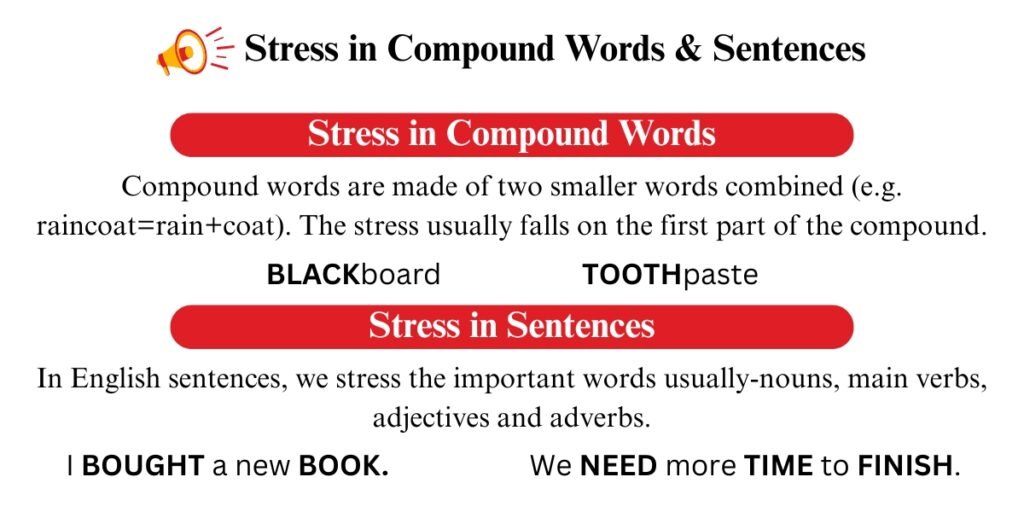
✨ In English, the tone of your voice matters just as much as the words you say. This tone, called intonation, is the natural rise and fall of the voice in speech 🎶. It gives meaning, emotion, and rhythm to your sentences. Without the right intonation, even correct sentences may sound flat, robotic 🤖, or confusing 😕.
At the intermediate level, one of the most important skills is learning the three main intonation patterns:
Falling intonation ⬇️ – used in statements and Wh-questions to sound complete and certain.
Rising intonation ⬆️ – used in yes/no questions or when checking information.
Rise-Fall intonation ⬆️⬇️ – used in exclamations to show strong feelings like surprise, excitement, or amazement.
In this lesson, you will learn how each pattern works, with clear examples, audio practice 🎧, and an image chart 🖼️ to guide you. By practicing regularly, you will develop more natural rhythm, confidence, and expression in your spoken English.
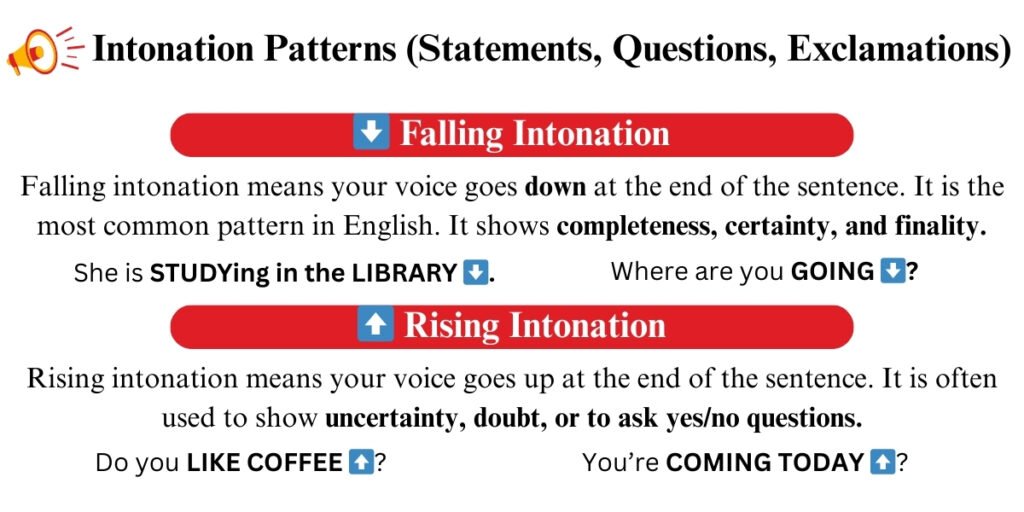
Have you ever noticed how English speakers sometimes seem to glide words together when they talk? Words don’t always stay separate—they link, and some sounds even get reduced or shortened. 🌊 This is called linking sounds and reduced forms, and learning them will make your English sound natural and fluent!
In this lesson, you’ll discover:
🔗 Linking sounds: How the last sound of one word can connect to the first sound of the next. Example: “I want to go” → sounds like “I wanna go”.
✂️ Reduced forms: How words get shortened in everyday speech. Example: “going to” → “gonna”, “want to” → “wanna”.
🎯 Practice tips: Listen carefully, repeat aloud, and try blending words in your own sentences.
Below, you’ll also find an illustrative image to see how words connect, along with an audio file to hear them in real-life sentences. 🎶
Let’s start practicing and make your English smooth, fast, and confident! 💪
